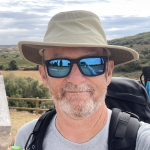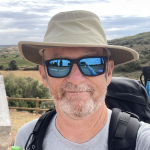For two years, I anticipated walking the Camino de Santiago, an enduring journey that promises self-reflection, discovery, and heightened awareness. Presented with an unexpected gift of time due to the COVID-19 Pandemic, I seized the opportunity to prepare myself thoroughly—physically, mentally, and spiritually—for this ancient pilgrimage. My goal was clear: to undertake a transformational, perspective-shifting experience that could be a once-in-a-lifetime opportunity. I was determined to make the most of it.
While preparing for the Camino de Santiago, I realized that my journey of self-discovery and heightened awareness had already begun. In addition to my physical training, I incorporated mindfulness and meditation into my routine, exploring a variety of books and apps to support this evolution.
At the same time the works of William B. Irvine came to my attention. Somehow, I stumbled upon his series, "The Stoic Path", which is featured on the Waking Up App hosted by Sam Harris. Stoicism has been a crucial component of my personal growth ever since I learned about Admiral Stockdale years ago, a man who overcame immense adversity as a POW in Vietnam.
Over the years, I've adopted many practices of Stoicism as part of my personal philosophy for leading a fulfilling life. I find Stoicism aids in processing my emotions and coping with life's inevitable challenges.
I was raised in a Christian tradition, and find the Stoic concept of contemplating the cardinal virtues aligns well with my understanding of being a Christian, even though I'm not one for religious rites and practices.
Like many who undertake the Camino de Santiago, I consider myself more spiritual than religious.
From Dr. Irvine, I learned about the concept of Fresh Eyes Projects. He explains how acquiring a new skill or hobby can provide a fresh perspective, leading to awe-inspiring experiences. I applied this modern Stoic wisdom to my preparations for the Camino.
I've always had an interest in learning to draw. So, I seized the opportunity. I became intrigued by the idea that learning to sketch would enable me to see with new eyes, and that sketching on the Camino might allow me to perceive my journey with enhanced wonder, curiosity, and appreciation.
It seemed natural to me to consider the Camino a Stoic path, a Stoic Adventure, as Dr Irvine might call it. Why? Because many view it as an initiatory journey that has both internal and external components.
To enhance my experience and cultivate a deeper connection with the Camino, I embarked on this new creative endeavor--learning to sketch--as I am accustomed to doing things with deliberate discipline and focused dedication.
As I contemplated my Camino, Cristina's Camino, and our shared journey, I found myself watching other Pilgrims on YouTube, yearning to capture my experience in a unique and personal way as they were.
The sketchbooks I noticed from other Pilgrims inspired me to create my own visual diary of the journey. To this end, I enrolled in online classes for travel and urban sketching, taught by skilled instructors such as Kari Gale, James Richards, and Liz Steel. With their guidance I was able to develop some rudimentary sketching skills to use on my Camino.
For clarification: when I refer to "Camino," I hope you understand that I'm also alluding to "life." The term "Camino" encapsulates my perception of life as a journey along a sacred path towards a sacred destination. In my view, the highest form of gratitude I can offer for the mere gift of being alive is to recognize and treat it as a sacred journey.
Much of my sketching practice leading up to the Camino was focused on learning the technical aspects through classes and exercises. Little of it resonated with what I'd describe as "the joy of sketching." However, on the Camino itself, I began to view my sketching as a tool for learning about and engaging with the world I was walking through. Post-Camino, I've found enjoyment in sketching as a mindfulness practice.
Looking back at this entire journey—from struggling to draw a decent circle, to embracing sketching as a mindfulness practice—it was a transformative experience in which the Camino played a significant role. Like many Urban Sketchers, I don't view this as art or consider myself an artist. I simply relish sketching and the impact it has on me.
Let me tell you more.
In late August of 2022, Cristina and I began walking from Saint Jean Pied de Port as Pilgrims. We continued walking 500 miles to Santiago de Compostela and then journeyed to the ends of the earth at Finisterre. After a brief visit to Muxía, both Cristina and I agreed that, at last, after 42 days, our Camino was complete.
Like many I've spoken with who walk the Way of St James, my aim was to learn a little bit more about myself, to test my limits and to contemplate my life's direction.
After many days of walking, and numerous profound experiences, I reached Santiago de Compostela still not knowing what I want to do with this last third of a good life, but understanding, if a little better, how I will live whatever it is I do choose to do.
Let me share some key details of my journey.
A two-hour online workshop led by Kari Gale equipped me with the basics of a sketching kit for documenting life and travel in a journal. Kari emphasizes the importance of seeing and capturing beauty in the mundane. Her published book, The Art of Walking: An illustrated journey on the Camino de Santiago was a large part of my inspiration for wanting to learn to sketch for our Camino, along with her Podcast, Pilgrim's Lost. In her class, Kari showed us how drawing slows you down allowing you to be fully present.
From Kari's sketching kit, I chose to carry two items: a small Altoids tin filled with cut pieces of Caran d'Ache Neocolor II Aquarelle Water-Soluble Crayons, which served as my portable watercolor palette. I paired this with a Pentel watercolor brush pen, which I used to apply washes to my ink pen sketches.
From James Richards' classes on Skillshare and reading his book Freehand Drawing and Discovery, multiple times, I practiced drawing with a simple Uni-ball Eye Micro pen and the inexpensive green Sailor Fude nib fountain pen, a favorite among many Urban Sketchers.
I also carried a single Prismacolor Col-Erase 20028 colored pencil, which I'd seen John Muir Laws using to sketch bird shapes in a YouTube nature-journaling tutorial. The pencil's pigment is so light that preliminary setup marks don't need erasing, a fact I found to be true. Therefore, I didn't carry an eraser.
I used a small Swiss army knife to sharpen the pencil—a tool that served various other purposes on the trek, from managing supplies and treating numerous blisters to opening the occasional bottle of Navarra, Rioja, and Ribera del Duero wine.
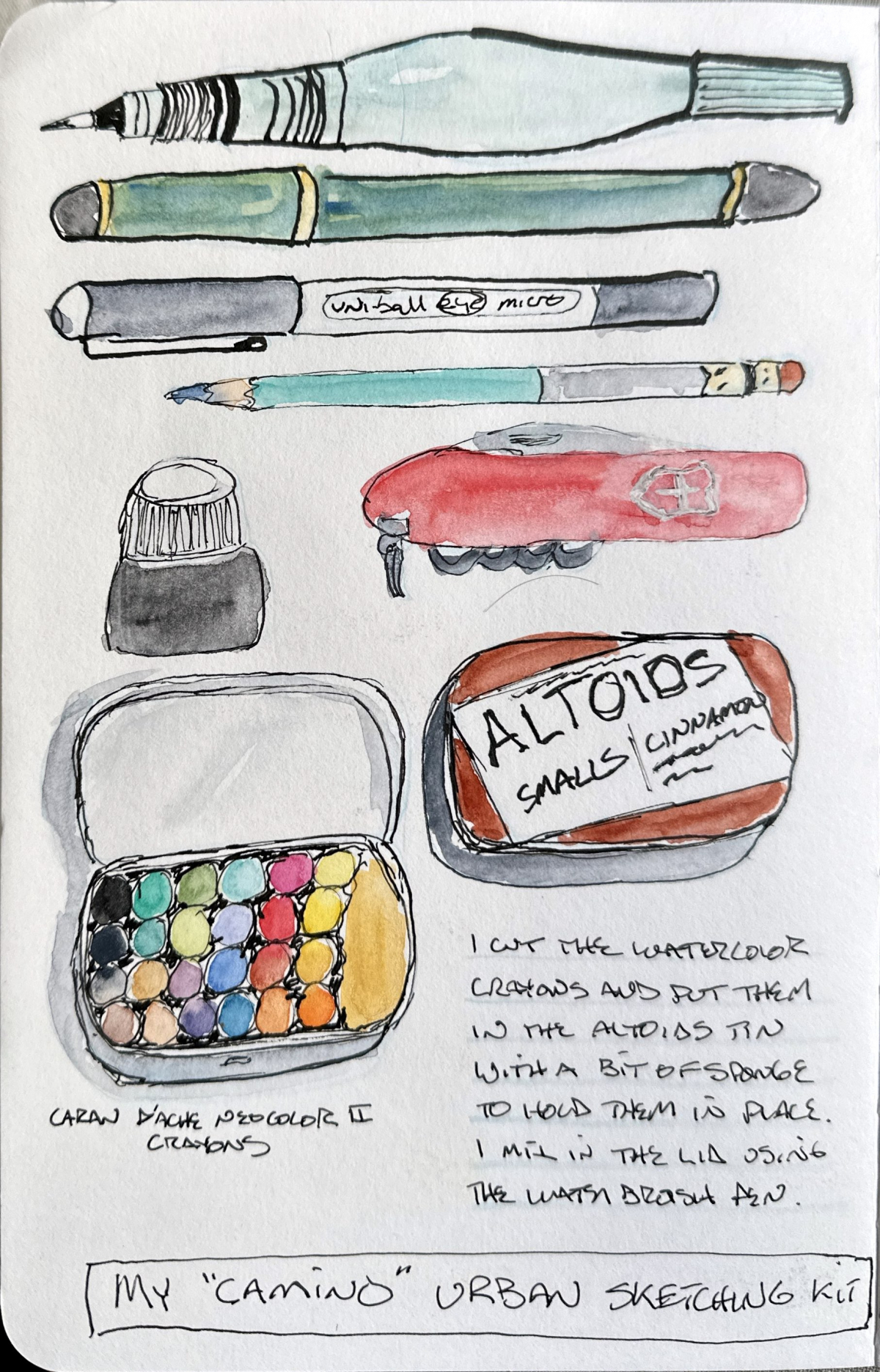
In total, my kit weighed 5 ounces, including the water in my brush pen. I also carried an 11-ounce, 8.25 x 5.5 inch Handbook Journal as recommended by Kari. Packing light is crucial on the Camino, so my entire kit, weighing in at 16 ounces, was indeed light—in comparison to the gear I've seen others bring to Urban Sketching events. However, it still represented a considerable weight to carry in a backpack across Northern Spain, on foot.
Now I consider Liz Steel to be my principle online sketching instructor, and her courses take you from fundamentals through drawing edges, buildings, watercolour, watercolour on location and on to sketchbook design. This in itself is a journey. I revisit these courses weekly, and I expect to continue doing so for years to come. Liz imparts a mantra to her students: "Feel the edges. Abstract the shapes. Construct the volumes. Embrace the wonkiness. We share but don't compare."
With my Camino experience, I've adapted some of what these inspiring instructors taught me and created this Camino Sketching mantra:
"I'm a Camino Sketcher. I capture the beauty of life in the ordinary. Sketching slows me down allowing me to be fully present. I feel the edges, abstract the shapes and construct the volumes of the experiences and places I encounter along my Way. I embrace the wonkiness of my efforts. Every Camino is different and every sketch is uniquely personal. I share my sketches, telling my story, but never comparing. Everything I do by hand is a sacred act."
Approaching sketching with this mindset, I've been able to train myself to pay attention to the details around me, to perceive the world with fresh eyes, and let go of expectations and comparisons. This heightened awareness enhances my life experience, making it even more meaningful, unique and personal.
Here is a sketch of the first monastery we stayed in at Roncesvalles, Spain after crossing the Pyrenees Mountains.
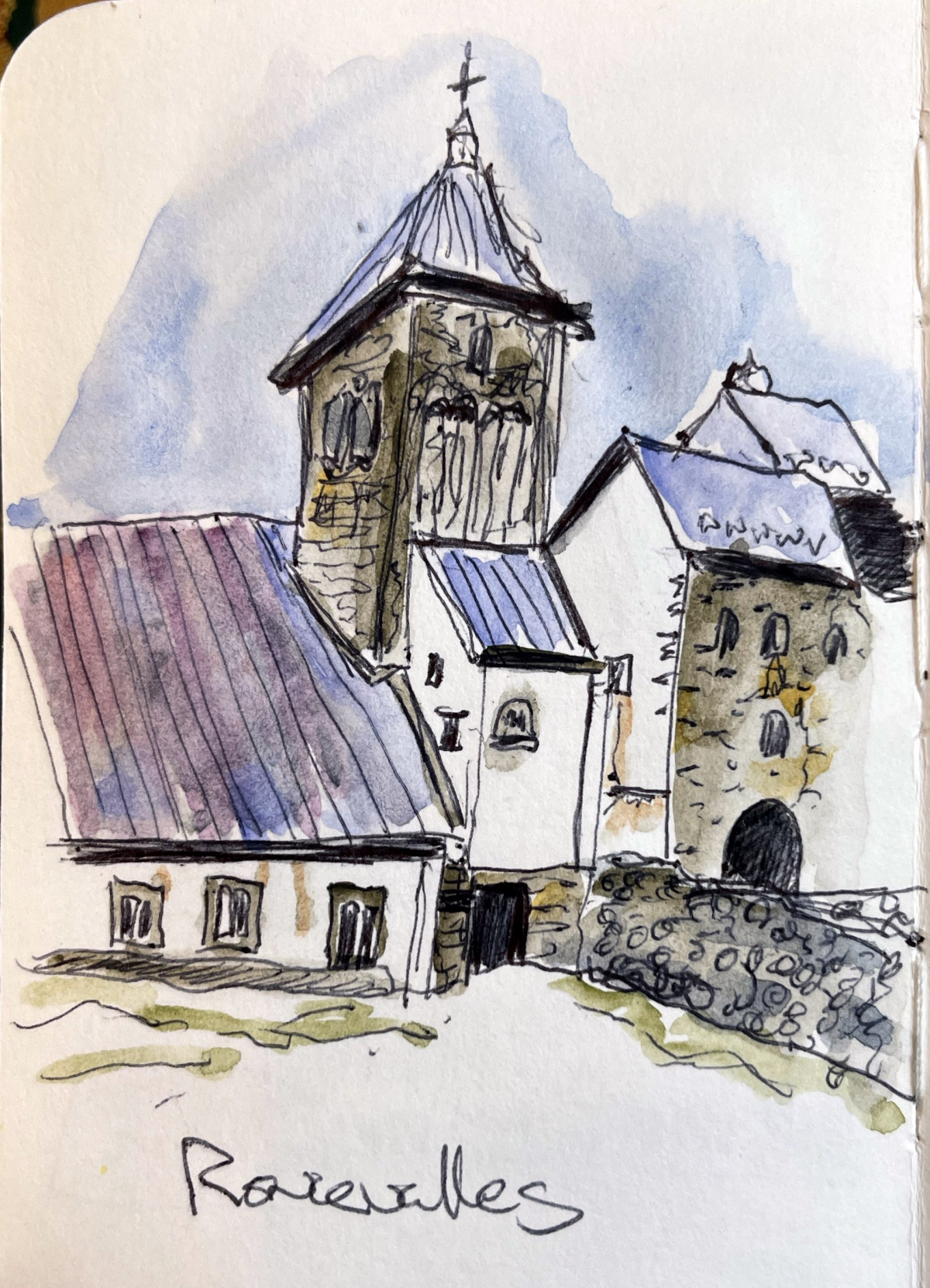
The following sketch is a quick one, made on the Camino during our late September walk from Triacastela, through Samos, to Sarria. It captures the quiet charm of a quaint little church in Freituxe, Spain. Despite the rain, that day was one of the most magical on our Camino journey.
I paused after passing the church and waited for Cristina, hoping to capture her in the frame. I had strategically positioned myself and was at the ready with my iPhone. However, my attention was quickly diverted by a pair of Spanish Mastiffs—each as big as a small bear—soaking wet and resting on the church's porch.
From my vantage point, I noticed one of the dogs keeping a watchful eye on me, and more disconcertingly, on Cristina. Although instances of dog bites are relatively rare on the Camino, I'd read enough accounts about Pilgrims requiring medical attention to be on high alert. I wanted to ensure I would be ready to rush to Cristina's aid, should the dogs decide to attack.
If you peer at my sketch, you might notice the faint blue pencil lines I used to map out the shapes and perspectives. I've yet to add any watercolor; when I gaze upon the sketch, the scene in my mind's eye is already vivid enough. I can still recall the verdant landscape, the looming stormy sky, and the wet calico fur of the Mastiff, warily eyeing my wife as she confidently strode past. The fear of provoking the dogs kept me rooted to the spot, a mere spectator in this tense scene.
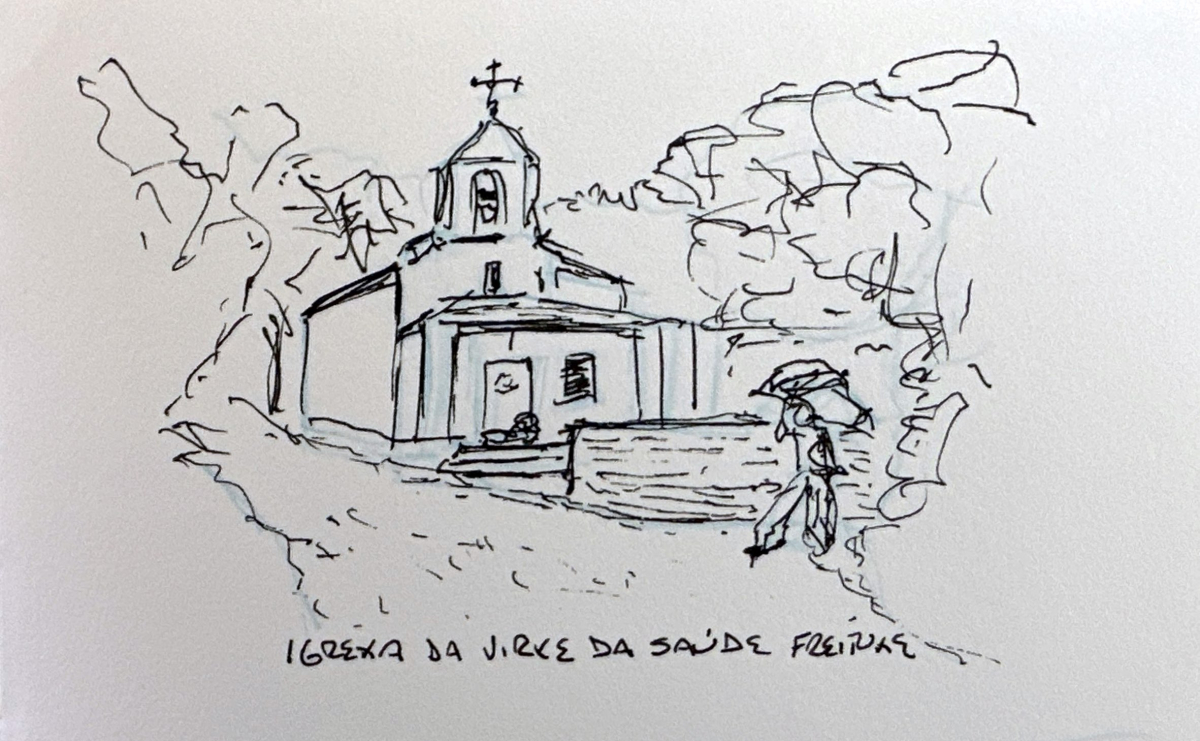
Later, I asked Cristina, "Did you see the dogs?" To my relief, she had. Now, as I recount the story, I can still feel the intensity of the moment, the sharp edges of my emotions captured in my lines and marks, and the abstract shapes that made up that memorable scene.
Sketching has become one of my modern Stoic practices. The ancients might consider it a practice of 'sympatheia' - the concept of embracing the interconnectedness and mutual relationships among everything in the world.
By observing and sketching my life, I foster a deeper understanding of my place in the universe and my connection to everything around me. It's a way to nurture a sense of unity and interdependence, to perceive the interconnectedness of all things, and to harmonize with the natural world.
Practicing sympatheia enables me to engage with life in a more profound way, to be fully present in the moment, and to appreciate the beauty of the journey. Through this practice, I've realized that my life's story is a mere thread in the larger, interconnected tapestry of life.
How could I not sketch the Inn of the Druid in Foncebadon, where we rested and prepared to madrugarse (wake up before dawn)?
The next day, we climbed up to the Cruz de Ferro under the cover of darkness, and witnessed a rebirth, as the sun emerged over the horizon.
Like others we deposited the burden stones we carried from Oregon and the Dominican Republic at the foot of the iconic cross, joining the silent testament of millions of other pilgrims. A pure manifestation of Sympatheia!

The sense of "sympatheia" on the Camino is often realized in the spontaneous formation of Camino families. Towards the end of our journey, we encountered Paolo, a young man from Italy, and we three became merry pilgrim companions. We then crossed paths again with Isa and Tony, and we all spent the entire day walking together. We stopped at a charming little cafe, rejuvenating ourselves with cafes-con-leche, and shared stories, our laughter ringing in the air.
Intrigued by the numerous bags Tony was carrying, I asked him about them. To my surprise, Isa and Tony revealed themselves to be professional, super talented artists from Brazil! Tony was carrying an astonishing assortment of art equipment that I estimate to have weighed at least 20 pounds. We exchanged and admired each other's sketchbooks, and I still remember the sound of Isa's encouraging words, urging me to continue sketching.
Later that night, I received a WhatsApp message. I had been added to the "Gruposito de Acuarela," the small watercolor group. Experiencing this sense of camaraderie and shared passion was pure Sympatheia!
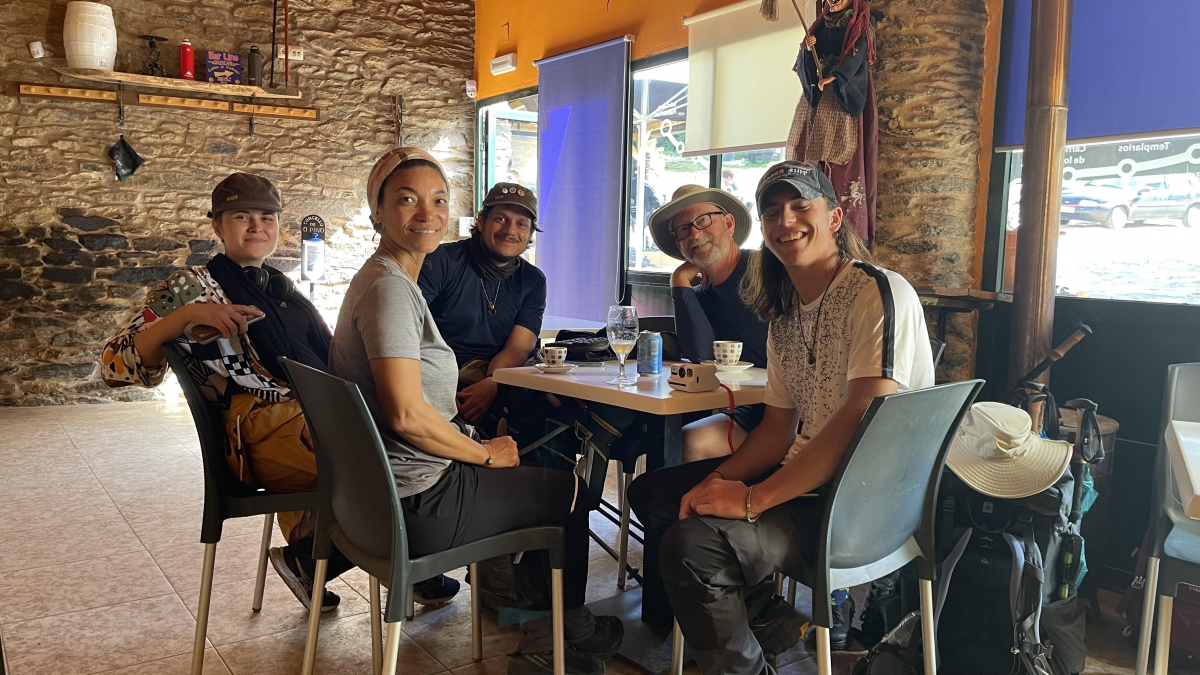
I believe the Camino is a metaphor for life, and Sketching is a metaphoric practice for paying attention and experiencing the world around us and celebrating being alive. The Sketcher becomes part of what they are sketching. When the Sketcher is present in this way, in the here-and-now, they are united with time itself, no past, no future, only now. Time becomes what the sketcher is, not something they can manage or orchestrate, but can never find enough of. This approach to the life and sketching is a reminder to slow down, pay attention, and appreciate the world around us.
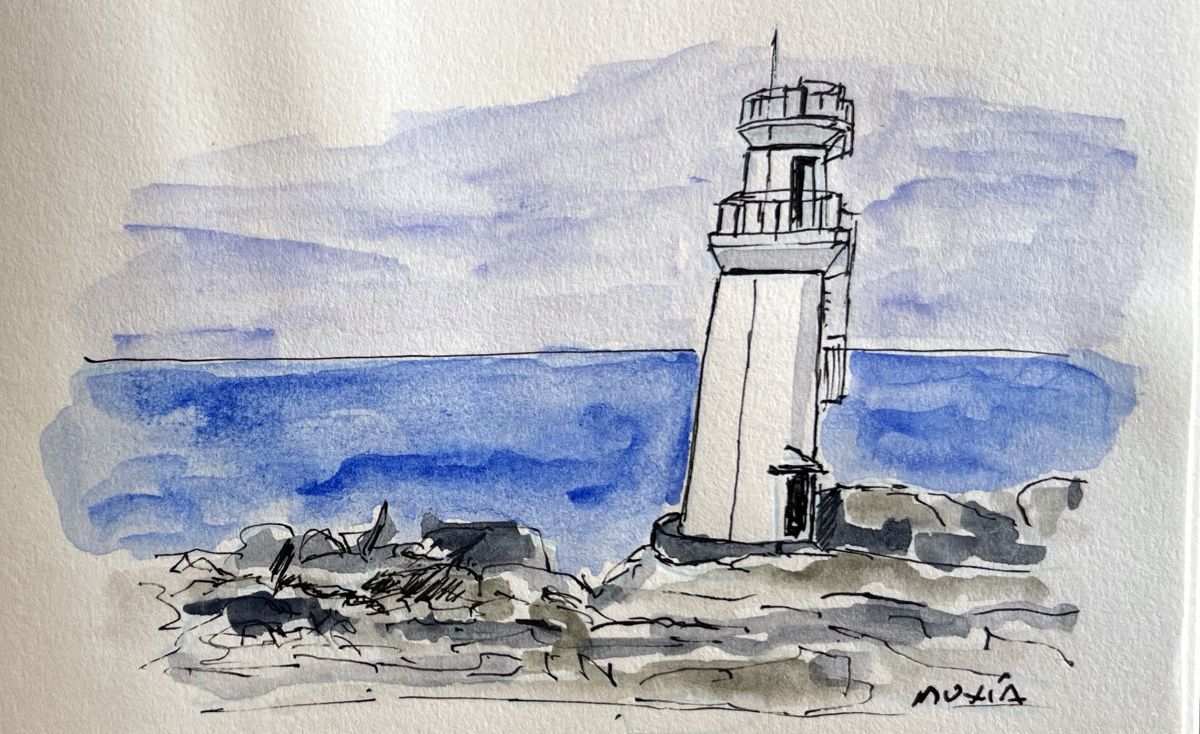
On our way back home to Florida we stopped in Madrid for a few days to visit family.
I was fortunate that the day after we arrived to join a group of Urban Sketchers in Madrid's Parque del Retiro to sketch the Palacio de Cristal.
I was very nervous as this was my first time sketching with a group of people and the first time I would be watched sketching in public. It is scary to sketch in public. Let me say that again. It is scary to sketch in public.
Somehow I had been able to sketch by myself, in magical solitude the whole length of the Camino de Santiago.
Let me say that attempting to sketch the Palacio de Cristal is scary in and of itself. Look at all those lines. Look at the glass and all the reflections. What?

So, how did I handle this new, scary, sketchy challenge in Madrid? The same way I've learned to handle many of my fears. I took a deep breath and felt the edges of the Palacio, abstracted the shapes, and... In that moment I became a card-carrying Urban Sketcher, a member of a "global community of sketchers dedicated to the practice of on-location drawing, sharing our love for the places where we live and travel—one drawing at a time." Pure Sympatheia!
It was surreal. I don't know how to describe it in any other way.
To complete my sketch of the Palacio (The first image at the top of this blog post) I stopped, on purpose, before I felt I was finished, to not over-elaborate it. I have learned that sometimes I go too far.
That gave me a few minutes to kill before we were to meet up and share our "masterpieces" in the classic throw-down, group-hug that always happens at the end of an Urban Sketchers event.
So, I walked to a new vantage point and threw a little wash on another page, trying a different approach where you sketch over the top of your wash. I have to work hard on my inner dialogue, my inner critic and sketching fast and loose helps me not to care so much. Which brings to mind another instructor I enjoy following on Youtube and Skillshare which is Toby "Urban Sketch" Hassler. Channeling my inner Toby, I sketched fast and loose, embracing the wonkiness of my lines, as I chatted with congregating strangers.

As people gathered, made comments and asked questions, Kari's little altoids kit caught the attention of a senior urban sketcher. He said he thought I had too many colors in my palette. I responded, you may be right, but I'm a beginner with not much experience in getting the shades I want with mixing. I then told him how this little kit, with its too many colors, had served me well on the Camino de Santiago we had finished walking a few days earlier. Of course, he being from Spain, nodded with knowing and glowing eyes.
For what it's worth, that's how I came to consider myself a Urban Sketcher, which for me is in essence a life sketcher who often enjoys going out and Urban Sketching with others.
In my view, learning to sketch can be as challenging and rewarding a journey as walking the Camino de Santiago itself. If we approach life with mindfulness and sympatheia it becomes a rich, perspective-changing and transformational journey, as meaningful as is walking in the footsteps of millions of Pilgrims on the Way of Saint James.
To all of my Urban Sketchers out there, or whatever you choose to call yourselves, I hope you find what you are looking for walking and sketching along your Way.
Buen Camino!
